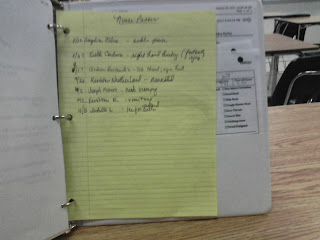This year, I decided to streamline all of the papers I need from day to day. Thus, I created this "everything book".
It always stays on my desk.
Although I need to tweak it a bit more, it really helps me keep things together.
The left pocket holds our school schedule and things I need to keep track of until they're due. For example, the Warm Body Count papers are clipped and stuck in the pocket.
The first papers I see are my lesson plans. Our department shares in lesson plan creation. Because they aren't always my own, it's great to have them at the ready for clarification.
The next section is seating arrangements. I have them in sheet covers.
When it's time for me to make my lesson plans, I have a section with the DOK chart, state standards, and goals we want to accomplish for the nine weeks.

In order to keep track of students who "regularly" ask me to go to the nurse (and just sick students in general), I decided to have a section for them in this binder. The yellow sheet you see is where I document the date, student name, and ailment. You can see part of the nurse's pass behind this yellow sheet. She has a detailed form that we follow. I keep the ones she has sent back with students to verify that they actually go to her. Sad that I have to do this but it's an ever present reminder that my lil' darlings can be sneaky. It does take an extra minute or two from my schedule, but it's a great reference I use for habitual requests. I simply go back and show them the documentation if the students ask me. Generally, when they see me logging their requests, they tend to not ask as much. Epic Win!






